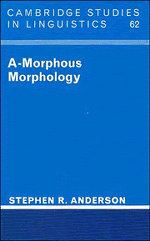Book contents
- Frontmatter
- Contents
- Acknowledgments
- Introduction
- 1 The study of word structure
- 2 Why have a morphology at all?
- 3 Is morphology really about morphemes?
- 4 The interaction of morphology and syntax
- 5 The theory of inflection
- 6 Some complex inflectional systems
- 7 Morphology in the lexicon: derivation
- 8 Clitics are phrasal affixes
- 9 The relation of morphology to phonology
- 10 How much structure do words have?
- 11 Composites: words with internal structure
- 12 Morphology and the typology of languages
- 13 Morphological change
- 14 Morphology as a computational problem
- References
- Index
2 - Why have a morphology at all?
Published online by Cambridge University Press: 10 January 2011
- Frontmatter
- Contents
- Acknowledgments
- Introduction
- 1 The study of word structure
- 2 Why have a morphology at all?
- 3 Is morphology really about morphemes?
- 4 The interaction of morphology and syntax
- 5 The theory of inflection
- 6 Some complex inflectional systems
- 7 Morphology in the lexicon: derivation
- 8 Clitics are phrasal affixes
- 9 The relation of morphology to phonology
- 10 How much structure do words have?
- 11 Composites: words with internal structure
- 12 Morphology and the typology of languages
- 13 Morphological change
- 14 Morphology as a computational problem
- References
- Index
Summary
This chapter is devoted to the question raised above of whether it makes theoretical sense to distinguish principles of morphology from those of other parts of a grammar. In section 2.1 we will look more closely at the system of a single language, Kwakw'ala, in which the grammar of words is particularly well developed. Among its many interesting features, Kwakw'ala allows us to examine the relation between morphology and syntax in some detail, because the language displays at the same time a rich and highly structured syntax, and an equally developed and highly structured system of word formation. When we look closely at the facts in these two domains, we will see that they are governed by rather different principles. The point of such a demonstration in the present context is to show that two quite separate rule systems govern Kwakw'ala ‘grammar’ (in the generalized sense of ‘morphosyntax’), and that the line between them corresponds to the difference between principles operating within a word and those organizing words into higher-level units.
Following this demonstration that an individual language may distinguish the grammar of words from the syntax of phrases, we consider the issue in more general terms. If we take seriously the suggestion that a system of principles governs the construction of words and their relations within a lexicon, and a different system governs the syntactic structure of phrases, clauses, etc., we would expect some systematic differences to obtain between the two systems.
- Type
- Chapter
- Information
- A-Morphous Morphology , pp. 22 - 47Publisher: Cambridge University PressPrint publication year: 1992



